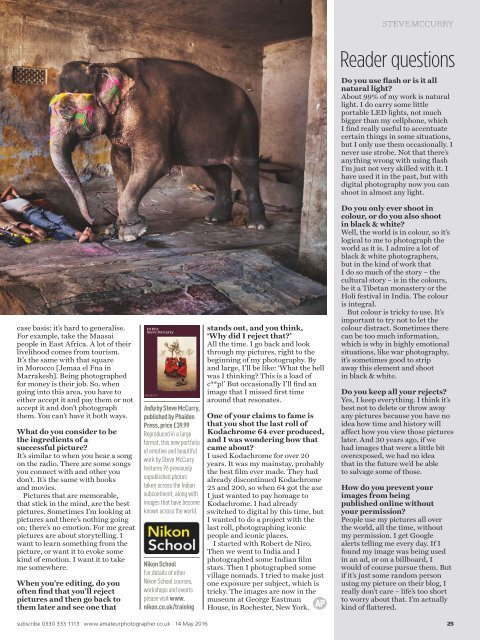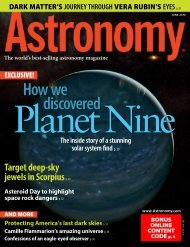Create successful ePaper yourself
Turn your PDF publications into a flip-book with our unique Google optimized e-Paper software.
steve COMPETITION<br />
mccurry<br />
Reader questions<br />
Do you use flash or is it all<br />
natural light?<br />
About 99% of my work is natural<br />
light. I do carry some little<br />
portable LED lights, not much<br />
bigger than my cellphone, which<br />
I find really useful to accentuate<br />
certain things in some situations,<br />
but I only use them occasionally. I<br />
never use strobe. Not that there’s<br />
anything wrong with using flash<br />
I’m just not very skilled with it. I<br />
have used it in the past, but with<br />
digital photography now you can<br />
shoot in almost any light.<br />
case basis; it’s hard to generalise.<br />
For example, take the Maasai<br />
people in East Africa. A lot of their<br />
livelihood comes from tourism.<br />
It’s the same with that square<br />
in Morocco [Jemaa el Fna in<br />
Marrakesh]. Being photographed<br />
for money is their job. So, when<br />
going into this area, you have to<br />
either accept it and pay them or not<br />
accept it and don’t photograph<br />
them. You can’t have it both ways.<br />
What do you consider to be<br />
the ingredients of a<br />
successful picture?<br />
It’s similar to when you hear a song<br />
on the radio. There are some songs<br />
you connect with and other you<br />
don’t. It’s the same with books<br />
and movies.<br />
Pictures that are memorable,<br />
that stick in the mind, are the best<br />
pictures. Sometimes I’m looking at<br />
pictures and there’s nothing going<br />
on; there’s no emotion. For me great<br />
pictures are about storytelling. I<br />
want to learn something from the<br />
picture, or want it to evoke some<br />
kind of emotion. I want it to take<br />
me somewhere.<br />
When you’re editing, do you<br />
often find that you’ll reject<br />
pictures and then go back to<br />
them later and see one that<br />
India by Steve McCurry,<br />
published by Phaidon<br />
Press, price £39.99<br />
Reproduced in a large<br />
format, this new portfolio<br />
of emotive and beautiful<br />
work by Steve McCurry<br />
features 96 previously<br />
unpublished photos<br />
taken across the Indian<br />
subcontinent, along with<br />
images that have become<br />
known across the world.<br />
Nikon School<br />
For details of other<br />
Nikon School courses,<br />
workshops and events<br />
please visit www.<br />
nikon.co.uk/training<br />
stands out, and you think,<br />
‘Why did I reject that?’<br />
All the time. I go back and look<br />
through my pictures, right to the<br />
beginning of my photography. By<br />
and large, I’ll be like: ‘What the hell<br />
was I thinking? This is a load of<br />
c**p!’ But occasionally I’ll find an<br />
image that I missed first time<br />
around that resonates.<br />
One of your claims to fame is<br />
that you shot the last roll of<br />
Kodachrome 64 ever produced,<br />
and I was wondering how that<br />
came about?<br />
I used Kodachrome for over 20<br />
years. It was my mainstay, probably<br />
the best film ever made. They had<br />
already discontinued Kodachrome<br />
25 and 200, so when 64 got the axe<br />
I just wanted to pay homage to<br />
Kodachrome. I had already<br />
switched to digital by this time, but<br />
I wanted to do a project with the<br />
last roll, photographing iconic<br />
people and iconic places.<br />
I started with Robert de Niro.<br />
Then we went to India and I<br />
photographed some Indian film<br />
stars. Then I photographed some<br />
village nomads. I tried to make just<br />
one exposure per subject, which is<br />
tricky. The images are now in the<br />
museum at George Eastman<br />
House, in Rochester, New York.<br />
Do you only ever shoot in<br />
colour, or do you also shoot<br />
in black & white?<br />
Well, the world is in colour, so it’s<br />
logical to me to photograph the<br />
world as it is. I admire a lot of<br />
black & white photographers,<br />
but in the kind of work that<br />
I do so much of the story – the<br />
cultural story – is in the colours,<br />
be it a Tibetan monastery or the<br />
Holi festival in India. The colour<br />
is integral.<br />
But colour is tricky to use. It’s<br />
important to try not to let the<br />
colour distract. Sometimes there<br />
can be too much information,<br />
which is why in highly emotional<br />
situations, like war photography,<br />
it’s sometimes good to strip<br />
away this element and shoot<br />
in black & white.<br />
Do you keep all your rejects?<br />
Yes, I keep everything. I think it’s<br />
best not to delete or throw away<br />
any pictures because you have no<br />
idea how time and history will<br />
affect how you view those pictures<br />
later. And 30 years ago, if we<br />
had images that were a little bit<br />
overexposed, we had no idea<br />
that in the future we’d be able<br />
to salvage some of those.<br />
How do you prevent your<br />
images from being<br />
published online without<br />
your permission?<br />
People use my pictures all over<br />
the world, all the time, without<br />
my permission. I get Google<br />
alerts telling me every day. If I<br />
found my image was being used<br />
in an ad, or on a billboard, I<br />
would of course pursue them. But<br />
if it’s just some random person<br />
using my picture on their blog, I<br />
really don’t care – life’s too short<br />
to worry about that. I’m actually<br />
kind of flattered.<br />
subscribe 0330 333 1113 I www.amateurphotographer.co.uk I 14 May 2016 25






